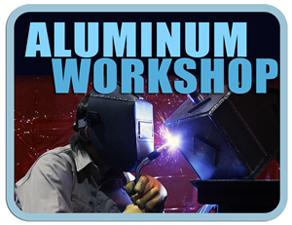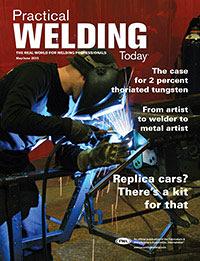President
- FMA
- The Fabricator
- FABTECH
- Canadian Metalworking
Categories
- Additive Manufacturing
- Aluminum Welding
- Arc Welding
- Assembly and Joining
- Automation and Robotics
- Bending and Forming
- Consumables
- Cutting and Weld Prep
- Electric Vehicles
- En Español
- Finishing
- Hydroforming
- Laser Cutting
- Laser Welding
- Machining
- Manufacturing Software
- Materials Handling
- Metals/Materials
- Oxyfuel Cutting
- Plasma Cutting
- Power Tools
- Punching and Other Holemaking
- Roll Forming
- Safety
- Sawing
- Shearing
- Shop Management
- Testing and Measuring
- Tube and Pipe Fabrication
- Tube and Pipe Production
- Waterjet Cutting
Industry Directory
Webcasts
Podcasts
FAB 40
Advertise
Subscribe
Account Login
Search
Aluminum Workshop: What to know when changing shielding gas with pulsed GMAW
- By Frank Armao
- May 12, 2015
- Article
- Aluminum Welding
Q: Recently I bought a new high-end pulsing power supply, which has different modes for all of the common materials and wire diameters. I was getting great results with 3/64-in. 5356 wire and 100 percent argon shielding gas. When I changed to a mixture of 70 percent argon/30 percent helium, the arc became very long and almost uncontrollable. Can you tell me what the problem is?
A: I think I can. First of all, I will try to give a general description here, rather than use any one company’s equipment as an example. The most important thing to remember in gas metal arc welding (GMAW) is that you must feed wire at exactly the same rate as you burn it off. Constant-voltage (CV) GMAW power supplies do this by allowing the current to vary. In synergic pulsing power supplies, the pulsed waveform is usually programmed by attaching a computer to the power supply and using the computer to program the pulsed waveform.
The welder/programmer chooses a wire feed speed (WFS), then adjusts some or all of the detailed pulsing parameters so that he has the right amount of arc energy at that WFS to burn off the preset WFS. He does this for a number of WFSs. The computer then interpolates between the data points and you have a smooth waveform at all WFSs.
It’s important to understand that the arc, which was so carefully programmed, depends on a number of variables, one of those being shielding gas composition. Changing the gas mixture can increase or decrease the arc voltage significantly. If that happens, you will not have the correct arc energy to burn off the preset WFS. The consequence is the arc will become either really long or really short.
Be aware that you cannot change shielding gas mixtures indiscriminately when using pulsing power supplies. You must use the same gas mixture that the manufacturer used to develop the waveform. If you need or want to use a different gas mixture, contact the power supply manufacturer. It might have a waveform developed for your shielding gas mixture.
By the way, you can also play this “mode” game to your advantage. Remember that the power supply is only putting out energy—it doesn’t know what material it is welding. So, if no preprogrammed mode fits your application, try other modes. It is common to find carbon steel or stainless steel modes for specific aluminum applications. We recently had need of a pulsed mode for 3/16-in.-dia. 5183. We didn’t have one, but we found out that a mode for 1/8-in.-dia. carbon steel worked fine. Don’t be afraid to experiment.
About the Author

Frank Armao
Aluminum Consulting Inc.
440-479-0239
About the Publication
Related Companies
subscribe now

The Welder, formerly known as Practical Welding Today, is a showcase of the real people who make the products we use and work with every day. This magazine has served the welding community in North America well for more than 20 years.
start your free subscription- Stay connected from anywhere

Easily access valuable industry resources now with full access to the digital edition of The Fabricator.

Easily access valuable industry resources now with full access to the digital edition of The Welder.

Easily access valuable industry resources now with full access to the digital edition of The Tube and Pipe Journal.
- Podcasting
- Podcast:
- The Fabricator Podcast
- Published:
- 04/16/2024
- Running Time:
- 63:29
In this episode of The Fabricator Podcast, Caleb Chamberlain, co-founder and CEO of OSH Cut, discusses his company’s...
- Trending Articles
Sheffield Forgemasters makes global leap in welding technology

ESAB unveils Texas facility renovation

Engine-driven welding machines include integrated air compressors

The impact of sine and square waves in aluminum AC welding, Part I

How welders can stay safe during grinding

- Industry Events
16th Annual Safety Conference
- April 30 - May 1, 2024
- Elgin,
Pipe and Tube Conference
- May 21 - 22, 2024
- Omaha, NE
World-Class Roll Forming Workshop
- June 5 - 6, 2024
- Louisville, KY
Advanced Laser Application Workshop
- June 25 - 27, 2024
- Novi, MI



























